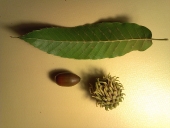


Unofficial Companion Guide to the Rocket Oven DVD
will be released to subscribers in:
soon!



 1
1




I wrestled with reality for 36 years, and I'm happy to say I finally won out over it.




We can green the world through random acts of planting.








Jd Gonzalez wrote:Could they be chinquapins?
I wrestled with reality for 36 years, and I'm happy to say I finally won out over it.




Jay Grace wrote:what did the husk look like? Did you pull it from the tree? Was it still green? Was the husk round or triangular?
what was the shape of the leaves?
I wrestled with reality for 36 years, and I'm happy to say I finally won out over it.
 1
1




We can green the world through random acts of planting.




 7
7




Twisted Tree Farm and Nursery
www.twisted-tree.net

 1
1




Lori Ziemba wrote:
Jay Grace wrote:what did the husk look like? Did you pull it from the tree? Was it still green? Was the husk round or triangular?
what was the shape of the leaves?
Here's a picture of an unopened husk. Seemed pretty round to me. This one is greenish, but I saw some on the tree that had already opened, and also had very small nuts. I put my finger in so you can see size.
List of Bryant RedHawk's Epic Soil Series Threads We love visitors, that's why we live in a secluded cabin deep in the woods. "Buzzard's Roost (Asnikiye Heca) Farm." Promoting permaculture to save our planet.




Jd Gonzalez wrote:https://www.flickr.com/photos/oikostreecrops/4403791431/in/photostream
Chinquapin Hybrid Chestnut — Castanea pumila hybrida.
Kind of looks similar.
I wrestled with reality for 36 years, and I'm happy to say I finally won out over it.




I wrestled with reality for 36 years, and I'm happy to say I finally won out over it.




I wrestled with reality for 36 years, and I'm happy to say I finally won out over it.




I wrestled with reality for 36 years, and I'm happy to say I finally won out over it.




I wrestled with reality for 36 years, and I'm happy to say I finally won out over it.








Argue for your limitations and they are yours forever.




Marlo Mattson wrote:Could it be that the trees are not receiving enough water?
I wrestled with reality for 36 years, and I'm happy to say I finally won out over it.








 1
1




 1
1




 1
1
















 2
2




Moderator, Treatment Free Beekeepers group on Facebook.
https://www.facebook.com/groups/treatmentfreebeekeepers/





 2
2




Michael Cox wrote:UK based.
My hunch is that the small nuts you describe are due in part to shorter growing season than the original range of the species.
I wrestled with reality for 36 years, and I'm happy to say I finally won out over it.








Life's too short, eat desert first! [Source of quote unknown]
You have to be warped to weave [ditto!]




Dan Schubart wrote:Thanks for all the discussion. This clears up some confusion on my part and I'm grateful for all the Permies' contributions.




 2
2




Moderator, Treatment Free Beekeepers group on Facebook.
https://www.facebook.com/groups/treatmentfreebeekeepers/






|
And tomorrow is the circus! We can go to the circus! I love the circus! We can take this tiny ad:
The new purple deck of permaculture playing cards
https://www.kickstarter.com/projects/paulwheaton/garden-cards
|





